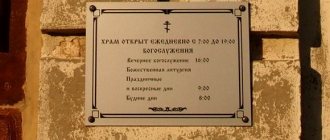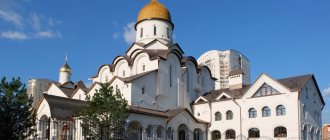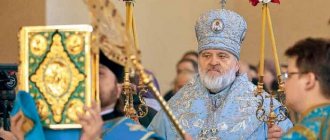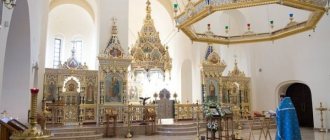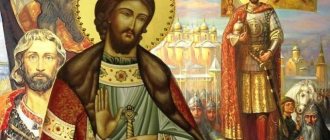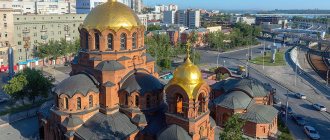What is a commemoration
In many families where the traditions of Christianity are honored, there is a special book - a commemoration book, where the names of living and deceased relatives are entered, and which should be submitted to the church for commemoration during the service. If your family still does not have such a book, the memorial can still be purchased in churches or Orthodox book stores.
A memorial is a record for posterity about the ancestors who lived on earth, which makes the memorial a book that is important for every Christian and forces them to treat it with respect. Memorials are kept clean and tidy, near household icons.
Should you be upset if you think that your note was not read?
Serving remembrances of the deceased is an expression of our love for them. But true love does not lie in just offering remembrance, ordering a prayer service or memorial service and then calming down or even leaving the temple. Those who have given remembrance must themselves, if possible simultaneously with the clergy, prayerfully remember their loved ones both during the proskomedia, and after the consecration of the Holy Gifts, and in other cases of public or secret commemoration of the living and the dead.
“The commemoration of relatives,” writes Saint Ignatius (Brianchaninov), “is heard equally by God both from the altar and from the place where you stand.” Remembrance during Divine services is equally useful and fruitful, whether the priest pronounces the names, whether those serving at the altar read the commemorations, or whether the pilgrims themselves silently commemorate their dead, each standing in his own place. All prayers, even those said secretly in church during Divine services, are ascended to the Throne of God through the officiating primate.
During the services of general memorial services, especially on parental Saturdays, when the number of those commemorated increases, the clergy sometimes do not have the physical opportunity to read all the commemorations at least once and are forced to limit themselves to reading only a few names in each commemoration. The duty of the pilgrims themselves is to share and make up for the work of the clergy. Every pilgrim can, during every litany, during every exclamation, during a memorial service or funeral matins, remember his loved ones, read his memorial.
As you know, during the services of the holy righteous John of Kronstadt, so many notes were given that if you were to read them all, especially aloud, it would take much more time than the rest of the service. Therefore, usually the holy righteous John of Kronstadt only placed his hand on the whole pile of notes, mentally remembering all those written in, and all those praying were sure that the commemoration was done as it should. This, according to the faith of those praying, always happens in the Church of God, when for some reason the memorials submitted by pilgrims cannot be read by the clergy themselves. The Omniscient knows all names. The knower of the heart sees the love of the living for the dead, knows their zeal and disposition to pray for the deceased, and accepts the general prayer of the Church for those who offered and for their sake, as a commemoration of each individual.
What are notes “On health” and “On repose”
A church note “On health” or “On repose” is, in essence, a one-time memorial. Such a note requires the same respect as a memorial book. It should be filled out carefully according to the established rules.
A note submitted without an image of a cross, written in sloppy, illegible handwriting, with many names, indicates a lack of understanding of the sacred importance and high purpose of recording the names of the living and deceased for their commemoration.
Meanwhile, memorials and notes, both in their appearance and in their use, can be called liturgical books: after all, the Holy Cross is depicted on them, they are brought into the altar, and read during the Divine Liturgy before the Holy Altar.
How to correctly write a note “On health” and “On repose”
- Notes must be submitted before the start of the liturgy. It is best to submit notes of remembrance in the evening or early in the morning, before the start of the service.
- When writing down the names of the living and the dead, remember them in the process of writing with a sincere desire for their good, from the bottom of your heart, trying to remember the one whose name you are writing in - this is already a prayer.
- The note must contain no more than ten names. If you want to remember many of your family and friends, send a few notes.
- Names must be written in the genitive case (answer the question “who?”).
- The names of bishops and priests are indicated first, and their rank is indicated - for example, “about the health” of Bishop Tikhon, Abbot Tikhon, Priest Yaroslav, then write your name, your family and friends. The same applies to notes “about the repose” - for example, Metropolitan John, Archpriest Michael, Alexandra, John, Anthony, Elijah, etc.
- All names must be given in church spelling (for example, George, not Yuri) and in full (for example, Alexander, Nikolai, but not Sasha, Kolya),
- The notes do not indicate surnames, patronymics, ranks and titles, or degrees of relationship.
- A child under 7 years old is referred to in the note as an infant—the baby John.
- If you want, in health notes you can mention “sick”, “warrior”, “travelling”, “prisoner” before the name. They don’t write in notes: “suffering”, “embarrassed”, “needy”, “lost”.
- In the notes “On Repose” the deceased is referred to as “newly deceased” within 40 days after death.
- It is allowed in notes “On repose” to write before the name “killed”, “warrior”, “of ever-memorable” (day of death, name day of the deceased).
- Notes for a prayer service or memorial service, which take place after the end of the liturgy, are submitted separately.
When is it necessary to commemorate the deceased?
The newly deceased is commemorated on the third, ninth and fortieth day after death, and the deceased - every year on the day of death (these days are called memorial days). Saint Simeon of Thessaloniki explains this custom this way: “Trinities (that is, commemoration on the third day after the death of the deceased) are performed because the Holy Trinity bestowed the remembered existence of the deceased, which even after repose will appear in its best form, having changed into a state better than what it was in beginning. Devyatiny (commemoration on the ninth day) are performed so that the spirit of the deceased... unites with the holy spirits of angels, so that through the intercession of these spirits, united in three faces, the Trinitarian God is propitiated and begged for the union of the human soul with the spirits of all saints. The Sorokousts are performed in remembrance of the Ascension of the Lord, which happened on the fortieth day after the Resurrection - and for this purpose, so that he (the deceased), rising from the grave, ascended to meet the Judge, being caught up in the clouds, and so would always be with the Lord.
Then the relatives commemorate the deceased every year, showing by this that he lives with them in soul, that he is immortal, that he will be renewed when the Creator desires and erects his body... Therefore, on all these days, it is necessary to commemorate everyone and with all possible care, especially it is necessary to combine these commemorations with the offering of the Most Terrible and Life-Giving Sacrifice, which was given for this purpose: because through petitions, prayers, consecrated sacrifices and charity to the poor, not only those who have sinned, but those who have departed in repentance, remission of sins, weakness and change of torment are granted , but also those who lived righteously and achieved a good and God-loving death, as Chrysostom thinks in his interpretation of the Acts, are given greater purification, higher degrees of approach to God, special boldness at the Judgment of Christ and predominantly the bright areas of the saints of God.”
The anniversary of the deceased, the day of his memory, is for those who remember it a kind of holiday, albeit of a sad nature. According to pious custom, along with those performing the commemoration, their living relatives and friends will take part in it and then they will remember the deceased with a kutia, and perhaps even a fuller meal.
Of course, commemoration can be performed in memory of the deceased at any other time, at the request of the person praying.
In addition to private commemoration, there is also a general church commemoration, at which all the fathers and brethren who have passed away from time immemorial are remembered. These Ecumenical memorial services (parental Saturdays) are celebrated on Meat Saturdays, Trinity Saturday, Demetrius Saturday, the 3rd and 4th weeks of Great Lent, as well as on Radonitsa and August 29 and are dedicated to the remembrance of all brothers in faith and those who were caught sudden death and were not guided into the afterlife by the prayers of the Church. On April 26/May 9, a commemoration is held for the deceased soldiers who laid down their lives on the battlefield for the Faith and Fatherland.
Whose names can be written in a note “about health”
In notes submitted for commemoration, the names of only those who have been baptized in the Orthodox Church are written.
The concept of “health” includes not only the health and physical condition of a person, but also his spiritual condition and material well-being. And if we pray for the health of a person who has done a lot of evil, this does not mean that we are praying that he will remain in the same state in the future - no, we pray to God that He will change his intentions and internal disorder, made sure that our ill-wisher or even enemy began to be in harmony with God, with the Church, with others.
This note should include everyone to whom we wish health, salvation and prosperity. The Word of God teaches that everyone needs to pray not only for themselves, but also for others: “pray for one another.” The Church is built on this common prayer for each other.
Now the health note is filled out in the following order:
- name of the Patriarch,
- name of the Archpastor,
- the name of your spiritual father, the priest who instructs you, cares about the salvation of your soul, prays to the Lord for you.
- parents' names,
- own name,
- names of your family members,
- names of loved ones and relatives,
- names of benefactors,
- names of envious people, offenders, enemies.
Why in this order?
- In Imperial Russia, all prayer services began with the name of the Sovereign Emperor, on whose “health” the fate of not only Russia, but also every family, every Orthodox Christian depended. Now we must first write the name of our Patriarch, and after him - the Archpastor, the Most Reverend Bishop, appointed by God as a spiritual ruler, caring for and offering prayers and sacrifices to the Lord for the flock entrusted to him.
- Then the name of your spiritual father, the priest who instructs you, takes care of the salvation of your soul, prays to the Lord for you: “Remember your teachers.”
- Then write the names of your parents, your name, the names of your family members, loved ones and relatives. Everyone should pray for the health and well-being of their family: “If anyone does not take care of his own, and especially his family, he has renounced the faith and is worse than an infidel.”
- Everyone should pray for the health and well-being of their family: “If anyone does not take care of his own, and especially his family, he has renounced the faith and is worse than an infidel.”
- For your family and relatives, write down the names of your benefactors. If they did good to you, then you should wish and pray for good and blessings from the Lord for them, so as not to remain in debt to them.
- Finally, if you have an ill-wisher, an offender, an envious person or even an enemy, write down his name for prayerful remembrance, according to the commandment of the Lord: (love your enemies, bless those who curse you, do good to those who hate you and pray for those who offend you and persecute you."
- Prayer for enemies, for those at war, is a great force for ending hostility and establishing peace. The Savior himself prayed for his enemies. There are many known cases when one of the warring parties wrote the name of his ill-wisher in the health note next to his name - and the hostility stopped, the former enemy became a well-wisher.
Cathedral of the Blessed Prince Alexander Nevsky, Izhevsk
About commemoration
The Church makes the main prayer for the health of the living and the repose of deceased Orthodox Christians at the Divine Liturgy, offering a bloodless sacrifice to God for them. To do this, before the start of the liturgy (or the night before), you should submit notes to the church with their names (only baptized, Orthodox Christians can be entered). At the proskomedia, particles will be taken out of the prosphoras for their health or for their repose, and at the end of the liturgy they will be lowered into the holy chalice and washed with the Blood of the Son of God as a sign of Christ’s washing away human sins. Let us remember that commemoration at the Divine Liturgy is the greatest benefit for those who are dear to us.
A church note given “On health” or “On repose” is a relatively recent phenomenon. In those families where the traditions of Orthodox piety are respected, there is a commemoration book, a special book in which the names of the living and the dead are written and which is presented during the service for remembrance. Memorial books can still be purchased in churches or Orthodox book stores. A memorial is a record for posterity about the ancestors who lived on earth, which makes the memorial a book that is important for every Christian and forces them to treat it with respect. Memorials are kept clean and tidy, near household icons. A church note, in essence, is a one-time commemoration and requires the same respect. A note submitted without an image of a cross, written in sloppy, illegible handwriting, with many names, indicates a lack of understanding of the sacred importance and high purpose of recording the names of the living and deceased for their commemoration. Meanwhile, memorials and notes, both in their appearance and in their use, can be called liturgical books: after all, the Holy Cross is depicted on them, they are brought into the altar, and read during the Divine Liturgy before the Holy Altar.
An eight-pointed Orthodox cross is usually placed at the top of the note. Then the type of commemoration is indicated: “On health” or “On repose”, after which the names of those commemorated in the genitive case are written in large, legible handwriting (to answer the question “who?”), with clergy and monastics mentioned first, indicating the rank and degree of monasticism (for example , Metropolitan John, Schema-Hegumen Savva, Archpriest Alexander, nuns Rachel, Andrey, Nina).
All names must be given in church spelling (for example, Tatiana, Alexy) and in full (Mikhail, Lyubov, and not Misha, Lyuba).
The number of names on the note does not matter; you just need to take into account that the priest has the opportunity to read not very long notes more carefully. Therefore, it is better to submit several notes if you want to remember many of your loved ones.
By submitting notes, the parishioner makes a donation for the needs of the monastery or temple. To avoid embarrassment, please remember that the difference in prices (registered or plain notes) only reflects the difference in the amount of the donation.
Also, do not be embarrassed if you did not hear the names of your relatives mentioned in the litany. As mentioned above, the main commemoration takes place at the proskomedia when removing particles from the prosphora. During the health and funeral litany, you can take out your memorial and pray for your loved ones.
Regarding additional information about the person mentioned in the note, the following must be said. The only thing the priest performing proskomedia needs to know is the name of the Christian given to him at baptism or (for monks) at tonsure, as well as the holy order or degree of monasticism, if any.
Many, however, indicate in their notes before the names some information about the age, rank or position of their relatives, for example, ml. (baby, that is, a child under 7 years old), neg. (adolescent or young woman - up to 14 years old), c. (warrior), bol. (sick, painful), concl. (prisoner, prisoner), put. (travelling, traveling), ub. (killed, killed).
The Orthodox Church does not welcome such a custom, but does not forbid following it. Last names, patronymics, worldly ranks and titles, and degrees of relationship are not indicated in the notes. You should not write “suffering”, “embarrassed”, “needy”, “lost”. In the notes “On Repose” the deceased is referred to as “newly deceased” within forty days after his death.
In addition to general services (liturgy, vespers, matins), in the Orthodox Church there are private services called services (since they are performed upon request, by order of parishioners), including a prayer service (for the living) and a memorial service (for the dead). They are usually performed at the end of the liturgy and are ordered in the same place where they accept notes and sell candles.
A prayer service can be ordered for the Savior (thanksgiving, for the sick, for those traveling, etc.), the Mother of God (for Her various icons) or revered saints - at the request of the parishioner.
At the end of the prayer service, the priest usually consecrates the icons and crosses, sprinkling them with holy water and reading a prayer.
The memorial service is served before the eve - a special table with an image of the crucifixion and rows of candlesticks. Here you can leave an offering for the needs of the temple in memory of deceased loved ones.
Notes for a prayer service or memorial service are formatted as follows: the type of note is indicated at the top (for example, “Prayer of thanksgiving to the Savior,” “Prayer to the Vladimir Icon of the Mother of God for health,” “Requiem service”), and then the names are written in the usual order.
In many monasteries there is a special requirement - the commemoration of the living and the dead during the reading of the Psalter (this is an ancient Orthodox custom).
Monasteries and churches accept notes to commemorate living and deceased Christians for 40 days (Sorokoust), for six months and for a year. In this case, the names are recorded in the funeral synodik and the brethren of the monastery or temple during the specified period during each service pray for our relatives.
Realizing that the most we can do for our loved ones (especially the deceased) is to submit a note of remembrance at the liturgy, we should not forget to pray for them at home and perform acts of mercy.
Who should and can be remembered in notes
In notes submitted for commemoration, the names of only those who have been baptized in the Orthodox Church are written. The first note we submit is “On Health.” The concept of “health” includes not only the health and physical condition of a person, but also his spiritual condition and material well-being. And if we pray for the health of a person who has done a lot of evil, this does not mean that we are praying that he will remain in the same state in the future - no, we pray to God that He will change his intentions and internal disorder, made sure that our ill-wisher or even enemy began to be in harmony with God, with the Church, with others. This note should include everyone to whom we wish health, salvation and prosperity. The Word of God teaches that everyone needs to pray not only for themselves, but also for others: “pray for one another” (James 5:16). The Church is built on this common prayer for each other. In Imperial Russia, all prayer services began with the name of the Sovereign Emperor, on whose “health” the fate of not only Russia, but also every family, every Orthodox Christian depended. Now we must first write the name of our Patriarch, and after him - the Archpastor, the Most Reverend Bishop, appointed by God as a spiritual ruler, caring for and offering prayers and sacrifices to the Lord for the flock entrusted to him. Many Christians do this, as the Holy Scripture teaches: “First of all, I ask you to make prayers, petitions, supplications, thanksgivings for all people, for kings and for all those in authority, so that we may lead a quiet and serene life in all piety and purity, for this is good and it pleases God our Savior, who wants all people to be saved and to come to the knowledge of the truth” (1 Tim. 2:1-4). Then the name of your spiritual father is written, the priest who instructs you, takes care of the salvation of your soul, prays to the Lord for you: “Remember your teachers” (Heb. 13:7). Then write the names of your parents, your name, the names of your family members, loved ones and relatives. Everyone should pray for the health and well-being of their family: “If anyone does not provide for his own, and especially for those at home, he has denied the faith and is worse than an infidel” (1 Tim. 5:8). For your family and relatives, write down the names of your benefactors. If they have done good to you, then you should also wish and pray for good and blessings from the Lord for them, so as not to remain in debt to them: “give everyone their due... Do not remain in debt to anyone except mutual love; For he who loves another has fulfilled the law” (Rom. 13:7-8). Finally, if you have an ill-wisher, an offender, an envious person or even an enemy, write down his name for prayerful remembrance, according to the commandment of the Lord: “love your enemies, bless those who curse you, do good to those who hate you, and pray for those who despitefully use you and persecute you” (Matt. 5, 44). Prayer for enemies, for those at war, is a great force for ending hostility and establishing peace. The Savior himself prayed for his enemies. There are many known cases when one of the warring parties wrote the name of his ill-wisher in the health note next to his name - and the hostility stopped, the former enemy became a well-wisher.
The second note we submit is “On Repose . In it we write the names of deceased relatives, acquaintances, teachers, well-wishers, everyone who is dear to us. Just as we pray for the living, so we must pray for the dead - and not only for our closest relatives, but also for our entire family, for everyone who did good to us in earthly life, helped, taught. The dead, although they have departed from us, although they remain flesh in the earth, but in soul with the Lord, have not disappeared, they continue to live a spiritual life invisible to us before the eyes of God, since the Lord Himself says in the Holy Gospel: “God is not the God of the dead.” , but alive, for with Him all are alive” (Luke 20:38). We believe that our deceased relatives, and we often do not know the names of many of them, pray for us, their descendants. We who live on earth, together with those who have departed from us, constitute one Church, one body, having One Head - the Lord Jesus Christ. “If we live, we live for the Lord; Whether we die, we die for the Lord: and therefore, whether we live or die, we are always the Lord’s. For to this end Christ died, and rose again, and lived again, that he might be Lord both of the dead and of the living” (Rom. 14:8-9). Our unity and communication with the dead is especially felt during fervent prayer for them. It produces an extremely deep effect and impression on the soul of the person praying, proving the real communication of the soul of the person praying with the souls of those for whom the prayer is offered.
How the Church commemorates the living and the dead at Proskomedia
Preparation begins during the proskomedia. Proskomedia is a part of the liturgy during which bread and wine are prepared for the sacrament. For proskomedia, five special prosphoras are used. From the first prosphora, after special prayers, the priest cuts out the middle in the shape of a cube - this part of the prosphora is given the name Lamb. This “lamb” prosphora rests on a paten, a round dish on a stand, symbolizing the manger in which the Savior was born. The lamb prosphora is actually used for Communion. From the second prosphora, the “Mother of God” prosphora, the priest takes out a portion in honor of the Mother of God. This particle is placed on the paten to the left of the Lamb. From the third prosphora, the “nine-time” prosphora, nine particles are taken out - in honor of the saints: John the Baptist, prophets, apostles, saints, martyrs and saints, unmercenaries, Joachim and Anna, and the saint in whose name the liturgy is celebrated. These taken out particles are placed on the right side of the Lamb, three particles in a row. After this, the clergyman proceeds to the fourth prosphora, from which they take out particles about the living - about the Patriarch, bishops, presbyters and deacons. From the fifth prosphora they take out particles about the deceased - Patriarchs, creators of churches, bishops, priests. These removed particles are also placed on the paten - first for the living, below - for the dead. Then the priest removes the particles from the prosphora served by the believers. At this time, remembrances are read - notes, memorial books, which we submitted to the candle box for the proskomedia. After reading each name indicated in the note, the clergyman takes out a piece of prosphora, saying: “Remember, Lord, (the name we wrote is indicated).” These particles, taken out according to our notes, are also placed on the paten along with the particles taken from the liturgical prosphoras. This is the first, invisible by those praying, commemoration of those whose names are written in the notes we submitted. So, the particles taken out according to our notes lie on the paten, next to the particles taken from special liturgical prosphoras. This is a great, holy place! The particles lying in this order on the paten symbolize the entire Church of Christ.
Many believe that the particles offered for the living and the dead are a cleansing sacrifice for our sins. It's a delusion. You can be cleansed from sin only by repentance, correction of life, mercy, and good deeds. The particles taken out from the prosphora we serve are not consecrated into the body of the Lord; when they are removed, there is no remembrance of Christ’s suffering: during the ascension of the Holy Lamb, during the proclamation “Holy to the Holies,” these particles do not rise for the mysterious elevation to the cross with the flesh of the Savior. These particles are not given in communion with the Flesh of the Savior. Why are they brought? So that through them the believers, whose names are written in our notes, receive grace, sanctification and remission of sins from the cleansing sacrifice offered on the Throne.
A particle taken from our prosphora, reclining near the most pure Body of the Lord, being brought into the chalice, filled with Divine blood, is completely filled with sacred things and spiritual gifts and sends them down to the one whose name is lifted up. After all the communicants have partaken of the Holy Mysteries, the deacon places into the chalice the particles of the saints, the living and the dead, reclining on the paten. This is done so that the saints, in their closest union with God, will rejoice in heaven, and the living and the dead, whose names are indicated in the notes, having been washed by the most pure blood of the Son of God, receive remission of sins and eternal life. This is also evidenced by the words spoken by the priest: “Wash away, O Lord, the sins of those who were remembered here, with Your Honest Blood.” That is why it is necessary to commemorate the living and the dead precisely in the Church, at the liturgy - after all, it is here that the cleansing of the sins we commit daily takes place through the Blood of Christ. The sacrifice made by our Lord Jesus Christ on Calvary and offered daily during the Liturgy on the Holy Throne is a complete and completely exhaustive payment for our debt to God - and only it, like fire, can burn away all of a person’s sins.
What is a registered note? In some churches, in addition to the usual notes about health and repose, they accept registered notes. A customized mass for health with a prayer differs from a regular commemoration for health in that, in addition to removing a particle from the prosphora (which happens during a regular commemoration), the deacon publicly reads the names of those commemorated in the litanies, and then these names are repeated by the priest before the altar. But even this is not the end of the commemoration according to the ordered note - after the end of the liturgy, a prayer is offered for them at a prayer service. The same thing happens at a custom-made mass of repose with a memorial service - and here, after removing the particles with the names of the deceased, the deacon publicly pronounces their names at the litany, then the names are repeated in front of the altar by the clergyman, and then the deceased are remembered at the memorial service, which takes place after the end of the liturgy . Sorokoust is a prayer service that is performed by the Church daily for forty days. Every day during this period, particles are removed from the prosphora. “Sorokousts,” writes St. Simeon of Thessalonica, - are performed in remembrance of the Ascension of the Lord, which happened on the fortieth day after the resurrection, - and with the purpose that he (the deceased), having risen from the grave, ascended to the meeting (that is, towards - ed.). Judge, he was caught up into the clouds, and so he was always with the Lord.” Sorokousts are ordered not only for repose, but also for health, especially for seriously ill people. Some churches and monasteries accept notes for eternal remembrance. If you submitted a registered note, then the names written in the notes are pronounced at prayer shortly after the reading of the Gospel.
How often should notes be submitted for remembrance? The Prayer of the Church and the Most Holy Sacrifice attract the mercy of the Lord to us, purifying and saving us. We always, both during life and after death, need God's mercy towards us. Therefore, it is necessary to be worthy of the prayers of the Church and the offering of the sacrifice of the Holy Gifts for us or our loved ones, living and deceased, as often as possible, and necessarily on those days that have special meaning: on birthdays, baptism days, name days of both one’s own and members of your family. Honoring the memory of the saint whose name we bear, we thereby call on our patron to pray and intercede before God, because, as the Holy Scripture says, the intense prayer of a righteous person can accomplish much (James 5:16). It is imperative to submit a note of remembrance on your child’s birthdays and baptisms. Mothers must carefully monitor this, because caring for the child is their sacred duty. Whether sin attracts us to itself, whether some passion takes possession of us, whether the devil tempts us, whether despair or inconsolable sorrow befalls us, whether trouble, need, illness have visited us - in such cases, the prayer of the Church with the offering of the Bloodless Sacrifice serves as the surest means of deliverance, strengthening and consolation.
REMINDER for those wishing to submit a note about the living and the deceased
1. Notes must be submitted before the start of the liturgy.
It is best to submit notes of remembrance in the evening or early in the morning, before the start of the service. 2. When writing down the names of the living and the dead, remember them in the process of writing with a sincere desire for their good, from the bottom of your heart, trying to remember the one whose name you are writing down - this is already a prayer. 3. The note must contain no more than fifty names. If you want to remember many of your family and friends, send a few notes. 4. Names must be written in the genitive case (answer the question “who?”). The names of bishops and priests are indicated first, and their rank is indicated - for example, “about the health” of Bishop Tikhon, Abbot Tikhon, Priest Yaroslav, then write your name, your family and friends. The same applies to notes “about the repose” - for example, Metropolitan John, Archpriest Michael, Alexandra, John, Anthony, Elijah, etc. 5. All names must be given in church spelling (for example, George, not Yuri) and in full (for example, Alexander, Nikolai, but not Sasha, Kolya), 6. The notes do not indicate surnames, patronymics, ranks and titles, degrees of relationship. 7. A child under 7 years old is referred to in the note as an infant—the baby John. 8. If you want, in health notes you can mention “sick”, “warrior”, “travelling”, “prisoner” before the name. They don’t write in notes: “suffering”, “embarrassed”, “needy”, “lost”. 9. In the notes “On repose” the deceased is referred to as “newly deceased” within 40 days after death. It is allowed in notes “On repose” to write before the name “killed”, “warrior”, “of ever-memorable” (day of death, name day of the deceased). Notes for a prayer service or memorial service, which take place after the end of the liturgy, are submitted separately. Facebook
Whose names can be written in a note “about repose”
The second note given in the church is “On Repose.” Names should be written in it:
- deceased relatives,
- deceased acquaintances,
- deceased teachers and mentors,
- deceased well-wishers who did good to you,
- all the deceased who are dear to you.
Just as we pray for the living, so we must pray for the dead - and not only for our closest relatives, but also for our entire family, for everyone who did good to us in earthly life, helped, taught.
The dead, although they have departed from us, although they remain in the flesh in the earth, and in soul with the Lord, have not disappeared, they continue to live a spiritual life invisible to us in the eyes of God. We believe that our deceased relatives, and we often do not know the names of many of them, pray for us, their descendants.
Our unity and communication with the dead is especially felt during fervent prayer for them. It produces an extremely deep effect and impression on the soul of the person praying, proving the real communication of the soul of the person praying with the souls of those for whom the prayer is offered.
About church candles
The simplest, but most effective type of sacrifice for the deceased is a candle, which is placed for his repose “on the eve.” Kanun is a rectangular table with a marble or metal board on which cells for candles are located. On the eve stands the Crucifixion with the Savior and the upcoming Most Holy Theotokos and the Apostle John the Theologian.
When we light a candle for the repose, we must offer prayers to the Lord for the departed whom we want to remember: “Remember, Lord, the souls of Your departed servants (their names), and forgive them all their free sins and involuntary, and grant them the Kingdom of Heaven.”
It is useful to donate to the church in memory of the deceased, give alms to the poor with a request to pray for the deceased.
Whose names cannot be written in notes “On health” and “On repose”
Who should not be mentioned in notes?
The Church does not commemorate the following people:
- suicides;
- not baptized in the Orthodox faith (atheists, heterodox, non-Orthodox);
- deceased, canonized saints. The reason is simple: being at the Throne of God, they are the ones who pray for us; - convinced atheists and fighters against God, even if they were baptized into Orthodoxy. You should not submit notes about them, you should pray for them at home.
Ordered note in church (mass)
In addition to ordinary notes about health and repose, Orthodox Christians accept custom notes. A customized mass for health with a prayer differs from a regular commemoration for health in that, in addition to removing a particle from the prosphora (which happens during a regular commemoration), the deacon publicly reads the names of those commemorated in the litanies, and then these names are repeated by the priest before the altar.
But even this is not the end of the commemoration according to the ordered note - after the end of the liturgy, a prayer is offered for them at a prayer service. The same thing happens at a custom-made mass of repose with a memorial service - and here, after removing the particles with the names of the deceased, the deacon publicly pronounces their names at the litany, then the names are repeated in front of the altar by the clergyman, and then the deceased are remembered at the memorial service, which takes place after the end of the liturgy .
The symbolic meaning of kutia
When burying the dead and remembering them, kolivo, or kutia, is brought to the temple - that is, boiled wheat seasoned with honey. Wheat means that the deceased will truly rise again from the grave: so wheat, thrown into the ground, first decays, and then grows and bears fruit. Therefore, the Lord Jesus Christ - our Resurrection - said: “Truly, truly, I say to you: unless a grain of wheat falls into the ground and dies, it remains alone; and if he dies, he will bear much fruit” (John 12:24). Honey consumed in kutia means that after the resurrection, the Orthodox and righteous will not have a bitter and regrettable life, but a sweet, favorable and blissful life in the Kingdom of Heaven.
Sorokoust
Sorokoust is a prayer service that is performed by the Church daily for forty days. Every day during this period, particles are removed from the prosphora. Sorokousts are ordered not only for repose, but also for health, especially for seriously ill people.
The forty-day commemoration includes both church commemoration, performed during the liturgy, and private home commemoration. Church commemoration takes place during the proskomedia; For a deceased Christian, the clergyman takes out a piece of prosphora, while saying: “Remember, Lord, (the name we wrote is indicated).”
Private commemoration in the first forty days after death consists of reading the Psalter and is usually performed by relatives, people close to the deceased, or a specially hired Christian.
Note for prayer service
A prayer service is a special divine service in which they ask the Lord, the Mother of God, and the saints to send mercy or thank God for receiving benefits.
In the church, prayer services are performed before and after the liturgy, as well as after Matins and Vespers. Public prayer services are performed on temple holidays, on New Year's, before the start of the youth's teaching, during natural disasters, during invasions of foreigners, during epidemics, during rainlessness, etc. Other prayer services belong to private worship and are performed at the requests and needs of individual believers. Often during these prayers there is a small blessing of water.
The note for the prayer service begins with an indication of which saint the prayer service is being offered, whether it is for health or repose. Then the names of those for whom the prayer song will be offered are listed.
When you submit a note for the prayer service, tell the minister whether you are ordering a water-blessing prayer service - in this case, a small blessing of water is performed, which is then distributed to the believers - or a regular one, without the blessing of water.
You can order commemoration of the living or deceased for a month, for six months, for a year. Some churches and monasteries accept notes for eternal remembrance.
Why are church notes written?
So that the names of your relatives are woven into the common prayer in the temple. After all, it is known that the more people pray for something, the sooner the Lord will listen to this request.
Find out what awaits you today - Horoscope for today for all zodiac signs
All notes discussed in this article are one-day ones . But there are also Sorokousts (a 40-day commemoration of a person), as well as six-month and annual commemoration . These names are recorded in the funeral synod. Such commemoration can be ordered not only in churches, but also in monasteries. For example, a monastery magpie can be recommended to a person who has lost a loved one and cannot come to terms with this loss for a long time.
There are also temples where you can buy “personalized bricks.” The name of a person is written on one of the bricks of the temple under construction, and there will be prayers for him every Sunday (as well as on holidays) while this temple stands. This is the so-called eternal remembrance .
Many Orthodox families have a small book - a commemoration book (pictured below). The names (church names) of all relatives - both living and deceased - are entered here. Such a book can also be served at a service.
Due to numerous requests from readers, we have prepared an “Orthodox Calendar” application for smartphones. Every morning you will receive information about the current day: holidays, fasts, days of remembrance, prayers, parables. Download for free: Orthodox Calendar 2021 (available on Android)
Where can I get a memorial? They are sold in temples.
Such little books are very convenient, because they can even be called a kind of family tree, which over time is passed on to children, and even grandchildren. In the house they are kept behind icons.
When and how often do you need to submit notes “about health” and “about repose”
The prayer of the Church and the Most Holy Sacrifice attract the mercy of the Lord to us, purifying and saving us. We always, both during life and after death, need God's mercy towards us. Therefore, it is necessary to be rewarded with the prayers of the Church and the sacrifice of the Holy Gifts for us or our loved ones, living and deceased, as often as possible, and always on those days that have special meaning:
- on your birthday,
- baptism day
- Name day of both your own and your family members.
Honoring the memory of the saint whose name we bear, we thereby call on our patron to pray and intercede before God, because, as the Holy Scripture says, the intense prayer of the righteous can do much.
It is imperative to submit a note of remembrance on your child’s birthdays and baptisms. Mothers must carefully monitor this, because caring for the child is their sacred duty.
Whether sin attracts us to itself, whether some passion takes possession of us, whether the devil tempts us, whether despair or inconsolable sorrow befalls us, whether trouble, need, illness have visited us - in such cases, the prayer of the Church with the offering of the Bloodless Sacrifice serves as the surest means of deliverance, strengthening and consolation.
